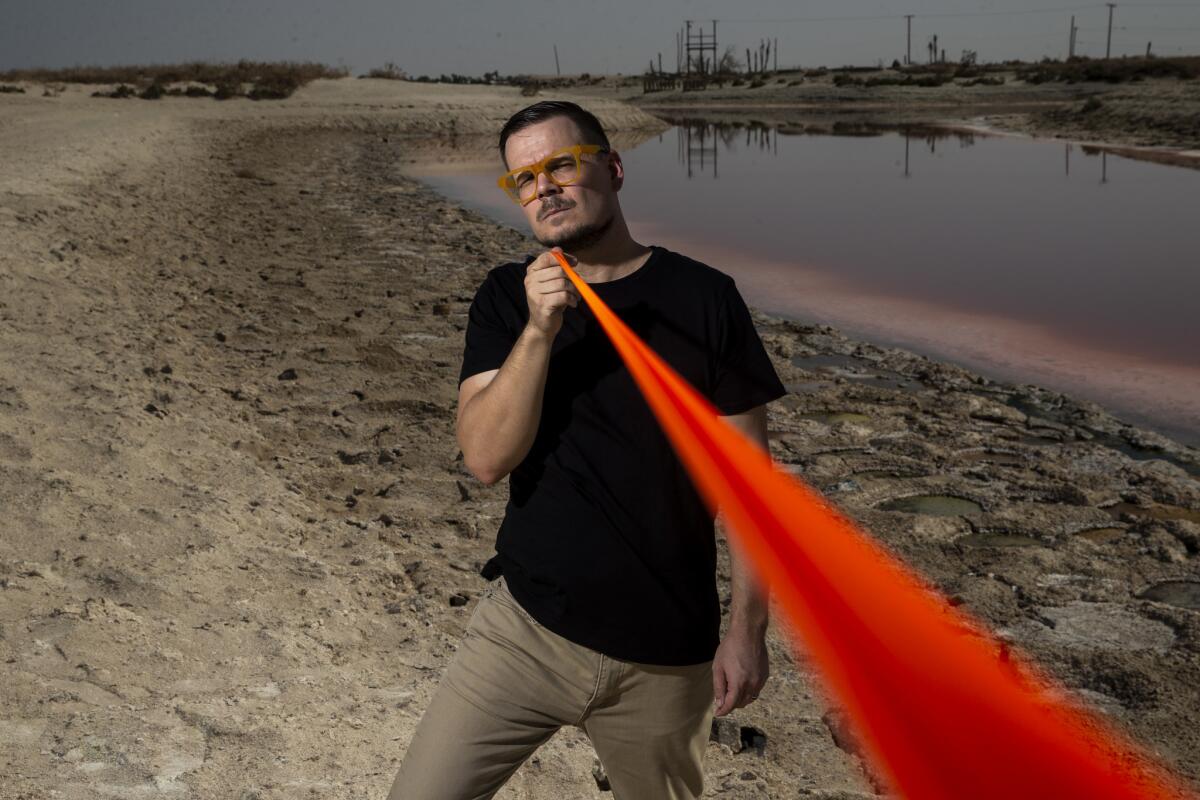Cristopher Cichocki’s art ponders the desert’s ancient oceans and the slow death of the Salton Sea

- Share via
When Cristopher Cichocki was a kid in Sturgeon Bay, Wis., he’d brave minus 70 degree wind-chill temperatures to explore nearby forests for natural material like sticks and leaves so he could make things out of them. When he moved to Southern California’s Palm Desert at age 10, he found himself doing the same — only with plants that thrived in temperatures nearly 200 degrees hotter. For Cichocki, there were striking similarities between underwater life and the curious flora that continues to occupy the yawning swath of seemingly barren California desert. Cichocki’s observation evolved into an investigation that formed the basis of his art practice, bringing him from the receding shorelines of the Salton Sea in his own backyard to Lancaster’s Museum of Art and History (MOAH), where the artist’s latest solo show, “Divisions of Land and Sea,” serves as a culmination of his exploration into the connectedness between earth and water.
After studying at CalArts and living in Los Angeles, Cichocki moved back to the desert in 2005. He currently resides in the Coachella Valley, where he often makes art out of found materials like old irrigation hosing, which he discovered at an abandoned citrus orchard in Indio Hills. That hosing appears at the museum as part of an evolving installation called “Sea Change (2016-2018).” The tumbleweed-like mass is perched atop a glittering wood-composite foundation. It is connected with a piping conduit to a living aloe vera plant, which is covered with marking paint and surrounded by sea salt, nestled in a found oil canister atop a palm stump. The work of art is meant to reference what Cichocki describes as “the surviving seeds of an ancient ocean,” but the gnarled ball of irrigation hosing at the center could just as easily be symbolic of the snarled bureaucratic mess surrounding the Salton Sea itself, whose future remains as murky as its shrinking water supply.
The Salton Sea was created in 1905 when water from the Colorado River flowed into a dry lake bed for two years following the breach of an irrigation canal. About a century later, the Salton Sea is shrinking. In 2003, California lawmakers implemented a 15-year plan to address the environmental concerns caused by the Salton Sea drying up. As the deadline passed, locals realized that more water was diverted from the lake’s source, the Colorado River, to surrounding communities, leaving the shores of the Salton Sea to recede further. It still is a public health hazard as toxic dust kicks up and asthma rates in Imperial County rise.
But the water in the Salton basin has been flooding and drying up repeatedly over the course of millennia, ever since the Cahuilla Native Americans first settled in the area roughly 10,000 years ago. In the 19th century alone, the Colorado River flooded the basin at least half a dozen times. It only threatened to become a problem in 1928, when Congress designated part of the Salton basin as a repository for agricultural wastewater.
“The issue with the Salton Sea is really the particulate matter that’s coming from it, because it’s surrounded by so much agriculture,” Cichocki explains. “When you have particulate matter, it’s not just the sand that’s blowing in the lot next door to you. It’s literally going into your bloodstream and it’s altering your DNA. It’s inescapable from your body at that point.”
Cichocki addressed his grim realization in a piece on display at MOAH called “Reservoir Issue.” In a heavy steel case, he placed 25 unopened cans of Cold War-era, government-issue emergency drinking water, a reference to what Cichocki says is “the privatization of material that is potentially everybody’s.” Next, he stratified layers of organic farming soil, synthetic sand, sea salt and barnacles from the Salton Sea, then incrementally poured a gallon of water through the whole piece, essentially creating an evolving installation that’s producing increasing amounts of salty, rust-like corrosion that continues to drip below.
“With the Salton Sea, you have about a hundred years of agricultural runoff like arsenic and selenium,” Cichocki says. “All these pesticides can store within barnacles [and] are filtered through,” just like the water making its way through “Reservoir Issue.” The application of water was risky for the artist, however. “I had no idea how that water was going to take, if it was going to be sealed,” Cichocki explains. “I knew it would probably drip. I kind of guessed that. But we’re talking a big roll of the dice.”
Throughout his practice, Cichocki has created multimedia pieces that not only address the cyclical aspects of nature, but especially the way humans have altered and affected Earth’s natural cycle through wide-scale development of manufacturing, production, construction and in this particular case, art. But Cichocki’s interests extend far beyond the terrestrial. He’s especially intrigued by the idea that what’s going on here on Earth may be a reflection of what is happening in the universe.
“Are we looking through the microscope or are we looking through the telescope, or are these things simultaneous?” he asks. One project, “Circular Dimensions,” is a completely immersive experience that includes sound art, video and even microscopic video painting, with scientists and artists manipulating material under a microscope, which is projected live onto circular panels.
The Salton Sea has long been an inspiration to Southern California artists, despite its perilous future. Communities of outsider artists have made site-specific installations throughout the region, creating a homegrown art scene. Nearby Salvation Mountain is a popular tourist spot, and Slab City’s post-apocalyptic town East Jesus is home to the Imperial Valley’s only official museum. What was once a quirky response to institutionalized art fairs, the Bombay Beach Biennale is starting to gain some legitimate attention. The environment around the Salton Sea itself serves both as an open studio and gallery.
For Cichocki, however, art inspired by the Salton Sea is more conceptual, which is why it seems to fit so neatly in a gallery setting. “I like to think of these as excavations, in a sense, and composing outside of the gestural kind of ego,” he explains. “I’m not interested in blending or making these idiosyncratic marks. I’m interested in industrial applications.”
Nonetheless, the artist describes himself as very much “site responsive” and says everything in the Lancaster museum is there for a reason. “I don’t think there are any arbitrary decisions, but still, there’s a lot of experimentation,” just like “Reservoir Issue,” for instance.
Cichocki also founded a residency for artists called Epicenter Projects, which began with a series of site-specific artworks adjacent to the San Andreas fault. Acting as a curator allowed Cichocki to investigate similar themes in his own paintings, such as the “San Andreas Series” and “Elemental Surfaces,” which examine impending disasters, natural and man-made. His oeuvre reflects and references a range of interests that requires an equally wide range of media to articulate. It’s something Cichocki does expertly and effortlessly — or at least, that’s how he makes it seem.
At its core, “Divisions of Land and Sea” is about the effect industry has on the natural world. It’s also a meditation and examination of water itself, as well as a subtle critique of institutional division between private and public property, symbolized in another motif running through the exhibit: red flagging tape. ”I find it such a funny thing. It’s such an official kind of material, right? But it’s so flimsy and so kind of ephemeral at the same time,” Cichocki observes. But not only does the red tape signify division, it’s also symbolic of the proverbial red tape created by the government: a sobering reminder that, while the Salton basin may have dried up repeatedly over centuries, this is the first time it’s the result of human intervention.
And this time, it’s the humans who are suffering.
“Divisions of Land and Sea” by Cristopher Cichocki
Where: Museum of Art and History, 665 W. Lancaster Blvd., Lancaster
When: Through Sept. 26
Info: (661) 723-6250, www.lancastermoah.org
More to Read
The biggest entertainment stories
Get our big stories about Hollywood, film, television, music, arts, culture and more right in your inbox as soon as they publish.
You may occasionally receive promotional content from the Los Angeles Times.










